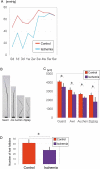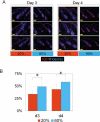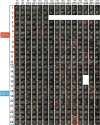The Effects of Ischemia and Hyperoxygenation on Hair Growth and Cycle
- PMID: 32727280
- PMCID: PMC7531622
- DOI: 10.1080/15476278.2020.1794271
The Effects of Ischemia and Hyperoxygenation on Hair Growth and Cycle
Abstract
Alopecia has several causes, but its relationship with ischemia/hypoxia has not yet been investigated in detail. In this study, we studied the changes of hair follicles induced by ischemia and potential effects of normobaric hyperoxygenation (NBO) on the hair cycle and growth. We found that skin ischemia reduced hair growth rate, hair shaft size, and its pigmentation in the anagen phase of mice, which may reflect an aspect of pathophysiology of hair loss (alopecia) and depigmentation (gray/white hairs). Hyperoxygenation increased hair growth rate in organ culture of both human and murine hair follicles. Systemic NBO promoted hair growth in early anagen and mid-anagen, and delayed catagen onset in mice. However, telogen-to-anagen transition was not affected by NBO as far as non-ischemic skin is concerned. The results of this study indicated that the hair follicle is very sensitive to oxygen tension and oxygen tension affects the regulation of hair growth and cycle in vitro and in vivo. It was suggested that systemic NBO can be safely applied for a long period and can be a noninvasive therapeutic approach to alter hair growth and cycle by manipulating the microenvironment of hair follicles.
Keywords: alopecia; baldness; depilation; hypoxia; ischemia; normobaric hyperoxygenation.
Figures







References
-
- Stenn KS, Paus R..Controls of hair follicle cycling. Physiol Rev. 2001;81:449–494. - PubMed
MeSH terms
Substances
LinkOut - more resources
Full Text Sources
